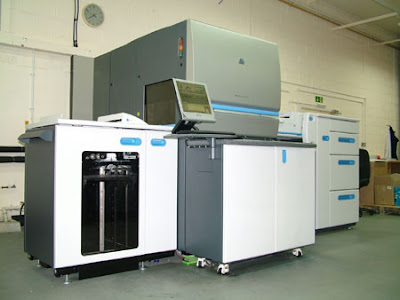Hi everyone! So today I'll do a quick overview of what you need to ask about when requesting printing quotes from commercial printers. I've found that generally the more knowledgeable you are about what they (the printers) do, the better relationships (and potentially better rates) a designer/illustrator can build with print shops.
To be perfectly honest, unless you're doing big business (whether a high number of orders of simply incredibly large print runs), you realistically aren't going to be getting huge discounts on print jobs. But, a) it doesn't hurt to ask, and b)knowing what you're talking about will help you be able to accurately compare different printers and their services.
So basic terminology:
Bleed - your printed image has a bleed if anything printed (text, design, background color, whatever) runs to the edge of the card. Instead of slowing everything down and trying to print right to an edge, what printers do is they print larger than the final size, then cut the card down to the final, or trim, size.
4/0, 1/1, etc., etc. Any number over another number (in x/y form) refers to the numbers of colors of ink on the front of the card, then the number of colors on the back of the card. If you wanted a two color image printed on the front of the card, and your logo in black and white on the back, you would request a quote for 2/1.
Full color (like a color photo) will usually be printed in CMYK (cyan, magenta, yellow, and key aka black). So even though your illustration might have yellows and purples and reds and greens, and everything in between, when you request a quote for a single-sided poster, you're asking for a 4/0 print job.
If there's an option for scoring, or the process of making a crease or foldline, you don't need it unless you're doing something with folds.
Perhaps you've heard the words "offset" and "digital" printing thrown around. Offset printing is a printing method that offers more consistent printing, highly accurate color matching, and is great for high volume runs. Digital printing on a commercial scale is really just a really awesome inkjet printer. While it might not sound as awesome, it is usually way more affordable for smaller (~100-200) jobs. The quality of digital printing has also improved dramatically over the past couple of years, and the quality difference that I've personally seen is pretty slim, but to be perfectly honest I don't get a lot of things offset printed besides business cards.
PMS stands for the Pantone Matching System. This is the industry-standard of color and color matching. Pantone produces books of swatches that any commercial printer worth doing business with will have. If you are getting an offset run done of just a few colors, you can specify which PMS colors you want them printed in, and since the presses use pantone colors, you'll get exactly what you're looking for. With digital printing, they'll combine CMYK the best they can to get the color you want, but really bright, saturated colors usually come out more muted than expected.

You'll also want to specify your paper weight (if you have a preference) and/or paper brand, etc. Ask about PCW (or post-consumer recycled waste) if you're interested in finding out how much recycled content is in your paper choices as well.
So, with all that in mind, the quote I requested for some wedding invitations I recently designed went something along these lines:
Hello! I would like a quote for 100 5"x7" invitations printed 4/0 with a full bleed on 130 lb. Mohawk Options iTone stock without envelopes. Additionally, I also need 100 4"x6" RSVP postcards printed 4/4 full bleed on the same stock without envelopes. Also, what size bleed do you need? Thanks a lot!
I asked for a specific stock because a)I sent this to a printer I've worked with before, b)I wanted a 100% PCW paper and Mohawk Options is one of the few papers I know about that has pure white, heavy cardstock that's 100% PCW, and c)I know they print on HP Indigo printers, and the iTone stock is designed specifically for the Indigo.
Anyhoo, I know that's probably a lot of information, and it's just the tip of the iceberg in terms of getting things printed (I didn't even mention screenprinting, letterpress, or engraving), but hopefully that'll get you on your way to learning more about paper, and printing. If you have any questions about commercial printing, please feel free to ask and I'll do my best to help you out!
PS - Happy Birthday Monkey's Dad!


No comments:
Post a Comment